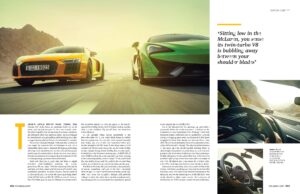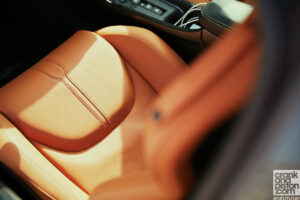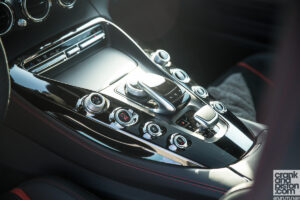Porsche vs. McLaren vs. Audi vs. Mercedes-AMG
Features | EVO Middle East | crankandpiston
Your choices for an all-round, everyday performance weapon are much wider than they were a few years ago. But which to go for: the McLaren 570S, the Audi R8 V10, the Mercedes-AMG GT S, or the new Porsche 911 Turbo?
Originally posted – 17 July, 2016
crankandpiston.com | EVO Middle East magazine (PDF)
There’s little doubt that, today, the 911 Turbo bares an enormous bulls eye on its chest, and not just because it’s the newest model here. Porsche’s flagship after all has long since been considered the definitive daily-use supercar, given the fine balance between breath-taking handling and everyday practicality Stuttgart has steadily perfected over the last few decades.
Times have changed though, with potential customers now eager for supercar-like performance at ever more reasonable prices, and consistently developing technology allowing rival manufacturers to close the performance/comfort gulf in ardent strides. In the last few years alone, Porsche has found more company than it would surely like in a fast-growing segment it once dominated.
Audi and McLaren in particular are keen to topple Porsche’s well-established pedestal, the second generation R8 and ‘baby’ 570S developed specifically for said task, and thus, ideal candidates to test Porsche’s long-established yardstick. In terms of price, they’re certainly in close proximity, the $201K McLaren squeaking ahead of the $171K Audi and $160K ($174K as tested) Porsche. The 911 Turbo gets its nose to 100kph two-tenths faster, but on power output, its rivals are again on the money: against the 533bhp Turbo, the 570S kicks 562bhp and the Audi a sizable 602bhp. Top speed? None are breathless at the triple ton.
In the metallic white corner meanwhile is the Mercedes-AMG GT S, the ironic black sheep in today’s four-way group test. It’s the only front-engined example here today, and one of only two rear-wheel drive spec models alongside the McLaren. It also drops nearly a full second to its rivals on the run to the ton, but with 503bhp on tap – despite being almost 100bhp down on the Audi – it should have the firepower to keep pace. At $155,500, it costs $45K less than the most expensive car here, making it the value proposition, and as a legit GT car, could hold the practicality trump card.
Not that the Porsche, McLaren and Audi lack practicality of course, something that’s put to the test – alongside other things – on one of our favourite stretches of asphalt, Jebel Jais. Since I’m incapable (though still perfectly willing) to drive the other three models simultaneously, my colleagues Steve, AJ and Jamil have graciously agreed to accompany me on the hill today.
I’m in the McLaren for the opening leg, and while I personally think the really-very-green detailing on the upholstery is more Sant’Agata than Woking, I can’t help but heave a sigh of relief that our test model does not boast the figure-hugging sport seats my admittedly fuller figure struggled to bond with during my last test drive. There’s no doubting the sense of occasion that comes with a McLaren cabin though. The slightly inclined nature of the seats, plus the slender-spoked steering wheel at chest height and pedals mounted deep into the footwell, just gives the impression of sitting in a Le Mans prototype. Despite sitting low in the carbon fibre tub, it feels like I’m perched right on top of the front axle with the weight of the 570S all behind me: I can sense the 3.8-litre twin-turbo V8 is bubbling away between your shoulder blades.
And yet at the same time, there’s a certain civility to the drama. Admittedly working your way past those beautiful butterfly doors still takes some forward planning in the McLaren, and yet the monocoque and side sills have been subtly altered to allow easier access. The definition of minimalist, the 570S houses a centre-mounted interface, plus a stalk to adjust the wing mirrors, and that’s basically it. Audi meanwhile, in full vorsprung durch technic guise, has gone more high tech with its driver centric infotainment system, single rotary controller and steering wheel-mounted Stop-Start button in vibrant, very teasing red. The driving position also feels significantly more sophisticated, the seats more centred (and vertical) than in the McLaren as the not-so heavily raked windscreen stretches way out in front. Throw in faultless build quality and active damping suspension for peerless ride, and the R8’s cabin is easily the most civilized of the group.
Granted this may sound like a kick in the teeth for the Porsche, but I’m reminded by Jamil that “it’s the one you’re most likely to get in and know how everything works.” Problem is this is also the 911’s Achilles heel. Though well put together and the only sports car here with rear seats (sort of), the Porsche cabin does feel understated – dare I say, a bit boring – compared with its flashier contemporaries, a new infotainment system and a 918-derived drive mode switch on the steering wheel the gist of the Turbo’s interior redesign. It’s particularly notable when compared with the AMG GT S, whose designer we assume has never heard the term ‘minimalist’. The enormous centre-console and its myriad buttons stray dangerously close to gaudy but fortunately the elegance of the build offers a reprieve. Though stiff, the AMG sport seats are probably the most supportive of any here today too, and while some elements of the cabin are maddening – the ignition switch is in the armrest – it’s at the very least distinctive. But, quite honestly, a bit cramped: I’ve had to open the glass roof’s sunshade to give myself an extra half-inch of headroom.
Admittedly these are not the usual observations of an evo supercar group test, something Steve brings an immediate halt to by bringing up the R8’s volcanic 5.2-litre engine: “it’s the only naturally-aspirated V10 here, it sounds incredible, and it moves like an S.O.B.” Without question, the R8’s heart and lungs steal the powertrain show on the mountain. The dizzying, near-9000rpm redline is impressive enough in itself, but it’s the immediacy of the initial kick and the energy throughout the rev range that really knocks our monogrammed socks off when said ten cylinders are wound all the way out. Into the high revs, there’s a crisp, almost refined savagery that elicits a high-pitched wail of pure anger, a welcome respite from the V10’s traditional droll rumble. The speedy shifts through the twin-clutch seven-speed automatic meanwhile are so seamless, you’d swear the system is reading your mind. This thing is seriously, lunatically, hilariously rapid.
To call its rivals slow however would be absurd. The Mercedes’ twin-turbo V8 is nowhere near as crisp in its delivery, nor for that matter is the initial get-up-and-run as quick. The V8’s more muscular, more visceral delivery however is enormously fun in its predictable lunacy. It starts with a blip of the throttle – just one – that unleashes a torrent of deep-throated rumbles, tipped by several ratchet-like pops on the overrun. It’s a sound of pure thunder from a V8 that dumps all of its torque and all of its power with minimal coercion: while the Audi’s Quattro four-wheel drive system means the R8 is up on its toes and running immediately, the AMG V8 is so aggressive and the turbocharger so alert, that it takes a few kilometres before I can find a usable balance on the throttle.
Softly softly then is the approach you’ll need to really draw out the more hyperactive GT S’ performance potential. Into the corners for instance, initial steering response is very sharp courtesy of a nicely weighted helm, allowing the front wheels to dart into an apex. Unlike the sharp, mid-corner bite of the Audi, Porsche and McLaren though, it never feels like the weight of AMG’s rear axle settles in the same way, meaning the rear wheels feel constantly on the edge of sliding. With direction changes soon coming thick and fast, the AMG just doesn’t offer the same precision as its rivals.
Not that I’m complaining: open the throttle mid-corner, and while the snap into oversteer is almost alarmingly quick, there’s enough pliancy in the chassis and more than enough front end bite to really get the AMG hauling. It’s lively and agile, and superbly exciting, even if it doesn’t offer quite the same intuitive, dynamic panache of its flatter-cornering rivals, which soon disappear into the distance. Not that this concerns AJ, a semi-professional drifter from his native Jordan: “how can you not love how mental this thing is? It just feels like the AMG is about to turn around and eat you.” An almost diametric opposite approach to that taken by the Porsche.
Steering heft in the 911 Turbo is equally as meaty albeit with slightly more support from the electric power-assistance and tangibly more feedback from the front wheels. It’s also fantastically locked down to the road, cornering flat thanks to the stiffness of the chassis, grip from the tyres and all-encompassing traction from the four-wheel drive setup. Open the taps mid-corner, and there’s so much lateral grip that neither understeer nor body roll make a dint in your momentum. Another ironic Achilles Heel of the Turbo.
The brutal delivery and often-times lairy rear end makes the less-than precise AMG GT S impossible to hate. With the 911 Turbo meanwhile, the balance is so neutral, the cornering so flat and the poise of the chassis so impressive that it can feel disengaging. There’s so little movement from the chassis and body that my inputs – be it through the steering or the throttle – seem almost redundant, despite the Porsche throwing me deep into the heart of the action. Overwhelming levels of mid-corner traction builds enormous confidence, and it’s not long before the 911 starts to eke out a lead through the more fiddly sections of our route. The performance potential is staggering and the 911’s limits seemingly endless. As a result, it just doesn’t feel like my efforts, as the driver, are an inherent part of the drive.
Fortunately here is where the turbocharged flat-six starts to chip away. The pull is immediate courtesy of the most rapid throttle response of all four. A brawny mid-range is also a far cry from its more laggy forebears, the 911 offering tangibly larger accelerative push across a wider rev-band. Even the upper notes of the six-cylinders give the Audi’s V10 a temporary run for its money. Throw in a broad torque curve and the Porsche is fantastically quick across the ground. Even if, when it comes to engagement, it can’t quite match the McLaren.
‘Playfulness’ is an area in which the McLaren excels. Mid-corner grip and superb balance mean chucking the chassis into the low-to-mid speed corners is embarrassingly easy. Dig the spur into the ribs a little harder though and suddenly McLaren’s ‘baby’ starts to come alive. The hydraulic steering is direct and wonderfully detailed in its feedback, communicative from turn-in all the way through the corner, allowing you to carry titanic speed. True, the V8’s delivery is not as gob-smacking as the Audi nor as raw as the AMG, but it’s a strong, linear pull that continues building in energy and vibrancy across the board, seemingly incapable of running out of steam.
Such is the mid-corner poise and grip available through those front tyres, you can really start to dial the power in early and lean on the front end. And yet, simultaneously, there’s just enough yaw under load that this phenomenal composure doesn’t feel alienating. Quite the contrary, in fact. There’s so much information being relayed through the steering column, so much punishment that the stiff carbon fibre monocoque is willing to soak up, that hustling the 570S feels so much more instinctive than the more serene 911 Turbo. Even the traction control works its magic subtly, refusing to slam down like a guillotine if it feels the rear wheels start to slip. The rest is up to you. The McLaren involves you. It rewards you. It truly makes you feel an indelible part of the experience.
Back in the Audi, and clearly the V10 has its work cut out. Drivetrain shock value is Ingolstadt’s for the taking today, but even despite blistering speeds, the V10 hasn’t quite got the measure of the McLaren through the corners. In all honesty, it all feels a little clinical.
The steering, not traditionally Audi’s forte, feels direct and responsive but doesn’t exactly overload the senses with feedback: you’re ultimately left to lean on the tyres and Quattro’s quick-witted traction to get the V10 hauling. Consequently the Audi just doesn’t feel as perceptive as the McLaren nor return the same detailed messages. Light and nimble through the corners, absolutely, thanks to an impressively tight body, and there are many occasions where the speeds we’re reaching seem scarcely credible. But there’s so much purchase under load that gentle understeer is the best you can hope for. It’s a shame, the aggression of that power delivery let down by handling that, frankly, feels too alienating to take my breath away.
Unsurprisingly, we lose track of time, and the skies – now thick with an aroma of punished tyres and brake dust – are dark before we start snaking our way back into Fujairah. We take refuge in a grotty café ahead of our near two-hour drive back to Dubai, our quartet of near-quarter million dollar performance weapons ticking itself cool in the parking lot as we do so. Several orders of chicken nuggets and half empty water bottles soon litter our cubicle, all but forgotten, as conversation bounces from this aspect of the McLaren’s chassis, the dynamic poise of the Porsche, and good God, how can you not love the Audi’s V10 punch? It’s a conversation that, as the minutes tick by, starts attracting the attention of our fellow diners, the small pool of carbon fibre-clad keyfobs in the middle of the table continuing to do so.
There’s soon a heavy chorus of support for the McLaren, led by myself. It may not have the same innate sense of absolute composure as the Porsche – easily the best handling of the bunch if we’re talking pure mechanics – but I love the manner in which the well-rounded steering, girthy V8 grunt and driver-focused agility makes the whole experience so much more rewarding. I will admit, as Steve dives back in with vigour, that the Audi’s almighty V10, superbly put together cabin design and benchmark ride quality would make the second gen supercar a worthy winner, were it not for its rather soulless handling.
Similarly the sheer ferocity and frankly hysterical manner in which the AMG butchers the turns, plus its all-round raucous character, puts it squarely in with a shout at outright victory, even if its composure under turn-in falls way behind that of its rivals. Several times before our run came to an end, I found myself jumping behind the wheel for one last go, much to the continued annoyance of AJ who’s already decided it’s the car for him. Ah yes, but what about the almost unstoppable wave of confidence the 911 Turbo offers you, proffers Jamil, and again, despite its distinct lack of playfulness as it bullies each turn into submission, I do have to admit a soft spot for the Porsche. Nothing, surely NOTHING can hustle the turns quite like the 911 can, the sports car benchmark it’s continually thrown down for five decades more than deserved.
But sorry chaps, my mind is made up. Even if this conversation goes on all night, even though the Audi’s powertrain is astonishing, the Mercedes’ muscular character intriguing, the Porsche’s mid-corner composure a thing of utter beauty, and the 570S is the most expensive of the four, I know which key fob I’ll be swiping from the table for the drive home. It’ll be the one with the McLaren ‘tick’.
Images | Awesome Group and Arun M Nair
Features | EVO Middle East | crankandpiston | James Gent






































